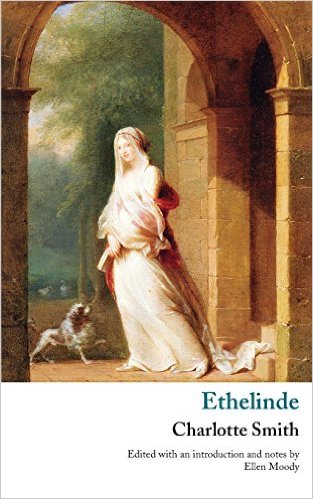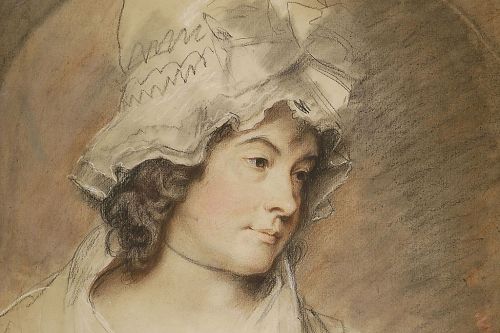
Jane Austen, whose love for the Gothic, even by parodying it, has helped to keep the Gothic tradition alive, even inspiring new Gothic works like Pride and Prejudice and Zombies in recent years.
In Jane Austen’s Northanger Abbey (1818), the heroine Catherine Morland and her friend Isabella Thorpe delight over reading the popular Gothic novels of the 1790s. While they are busy reading Mrs. Radcliffe’s well-known The Mysteries of Udolpho (1794) and plan to go on then to her novel The Italian (1797)—two of the best-known and best-written of the Gothic novels of the period—Isabella creates a list of seven other “horrid” novels that she suggests they read. This list includes two novels by Eliza Parsons, Castle of Wolfenbach (1793) and The Mysterious Warning (1796), Clermont (1798) by Regina Maria Roche, The Necromancer; or, The Tale of the Black Forest (1794) by Ludwig Flammenberg (pseudonym of Carl Friedrich Kahlert), The Midnight Bell (1798) by Francis Lathom, The Orphan of the Rhine (1798) by Eleanor Sleath, and Horrid Mysteries (1796) by the Marquis de Grosse. Two of the novels, The Necromancer and Horrid Mysteries were translated into English from German. The others are by English authors.
I will not discuss here all the novels but simply make a few comments. I have been reading them as they have been reprinted by Valancourt Press (which has done us a great service by reproducing them and so many other obscure but significant literary works of the eighteenth and nineteenth centuries). Unfortunately, I read all of them other than Horrid Mysteries, which I just finished, before I had a blog so I did not write about them as I read them.
The truth is the plots of these novels are largely forgettable so I can’t comment on them other than to recall that the two novels by Parsons and Clermont by Roche were very readable. (Plot summaries of all seven novels, some brief, some extensive, can be found on Wikipedia at: https://en.wikipedia.org/wiki/Northanger_Abbey#Allusions_to_other_works by clicking on links to the individual works).The finest of the novels was, in my opinion, The Orphan of the Rhine. It is the only one I can remember any of the plot to. The title orphan is a young woman in hiding. There is also a dastardly marchese who commits several crimes but repents on his death bed—a surprisingly early form of the Gothic wanderer villain redeemed. That said, I read this novel along with my friend, Jane Austen scholar Ellen Moody, who ended up writing the introduction to the Valancourt edition, and she pointed out that the marchese is not punished for his crimes but gets off easily by dying in the end; furthermore, while he repents, the marchese is forced into his confession. As for the other novels, the plots were convoluted and not memorable and would be difficult to summarize.
But one of these novels stands out as being truly “horrid” and not because of its ability to shock but because of its horrid plotting and writing. That novel is aptly titled Horrid Mysteries, and in the introduction to the Valancourt edition, Allen Grove makes this same point, that the writing may be considered horrid. He also points out that the disparity between the novels of Radcliffe and a novel like this one shows how undiscerning the reading public was in its desire for Gothic thrills.

Horrid Mysteries is the most convoluted if not the overall most horridly written of the Northanger novels.
Horrid Mysteries has a ridiculous, convoluted, and often hard-to-follow plot about a young man named Carlos who gains the attention of a secret society, the Illuminators in Bavaria. He is initiated into their rites but while they claim to be on his side, they continually seem to be working against him. He is often pursued or harassed as well by a creature named Amanuel (his name is always italicized), who seems to be some sort of spirit or “genius”—an evil spirit apparently, although at times Amanuel seems to act to save Carlos’ life when he is in favor with the secret society. (Amanuel ends up killed in the end so just how supernatural he is isn’t clear.) Carlos goes through no end of adventures, including loving Elmira, who ends up dying and being buried, only to show up later alive—the secret society allegedly faked her death. Later, Elmira is shot and again dies before Carlos’ eyes, only to return yet again. Finally, she dies and stays dead. Carlos ends up with another wife later, Adelheid, who gets him back into the secret society’s good graces—or is working for the secret society against him since she ends up having an affair with a baron associated with the society whom Carlos kills when he catches them together. Carlos then sends Adelheid to a convent to repent for her sins until she is worthy of him again. Eventually, she returns to him and Carlos is finally told he is safe from the society because the police investigated the baron’s murder, which caused the society to disband. Through four volumes, we follow these and Carlos’ other escapades across Europe, watching him often have romances with various women or spend time with male friends who are romancing women or have attractive wives who want to romance Carlos.
While there are secret societies in the novel, there’s only one really haunted castle scene, and overall, Horrid Mysteries is more of a picaresque novel of a young man’s adventures in the style of Tom Jones than a Gothic one. Indeed, it’s a wonder anyone could suffer through all four volumes of it—I did, but I found myself confused much of the time even though I took notes as I read to try to keep the multitude of largely undeveloped characters straight. There are plenty of sexual trysts and adulterous relationships to make Catherine Morland or any young female reader blush—in fact, I doubt any Gothic novel is so sexual except perhaps the much better written The Monk (1796) by Matthew Lewis.

The Orphan of the Rhine, a definition imitation of Mrs. Radcliffe’s Gothic novels, is probably the best of the Northanger novels.
For many years, scholars thought the seven Northanger novels were titles invented by Jane Austen, but research has now restored all of them to us. I would recommend readers curious about Gothic fiction and these novels in particular to start out by reading Northanger Abbey, then Radcliffe’s The Mysteries of Udolpho, and maybe The Italian, though I’m not a big fan of it and prefer her other novel The Romance of the Forest (1791). Once you understand the superb Gothic of Radcliffe, you can appreciate the works of her imitators, and all seven of these Northanger novels are in imitation of her except perhaps Parson’s Castle Wolfenbach which was published the year before Udolpho but not before The Romance of the Forest. I’d suggest you start with Orphan of the Rhine and then try Parsons’ novels, and then if you have the stomach for it, go on to the other ones, including the two German translations, which fall under the category of masculine rather than feminine Gothic (a complicated designation but a basic terminology would be that the feminine Gothic focuses on female heroines. I discuss these terms in more detail in my book The Gothic Wanderer: From Transgression to Redemption.)
These Gothic novels are but a footnote in literary history and would have been forgotten completely if not for Jane Austen, but while I did not care for all of them, the better ones still have the ability to give us the kinds of thrills and chills our ancestors experienced more than two centuries ago, and in truth, we would not have our superhero and vampire stories today if these books had not been written.
___________________________________________________________
Tyler Tichelaar, Ph.D., is the author of The Children of Arthur series, beginning with Arthur’s Legacy and including Lilith’s Love which is largely a sequel to Dracula. His scholarly nonfiction works include King Arthur’s Children: A Study in Fiction and Tradition and The Gothic Wanderer: From Transgression to Redemption. You can learn more about him at www.GothicWanderer.com and www.ChildrenofArthur.com.




